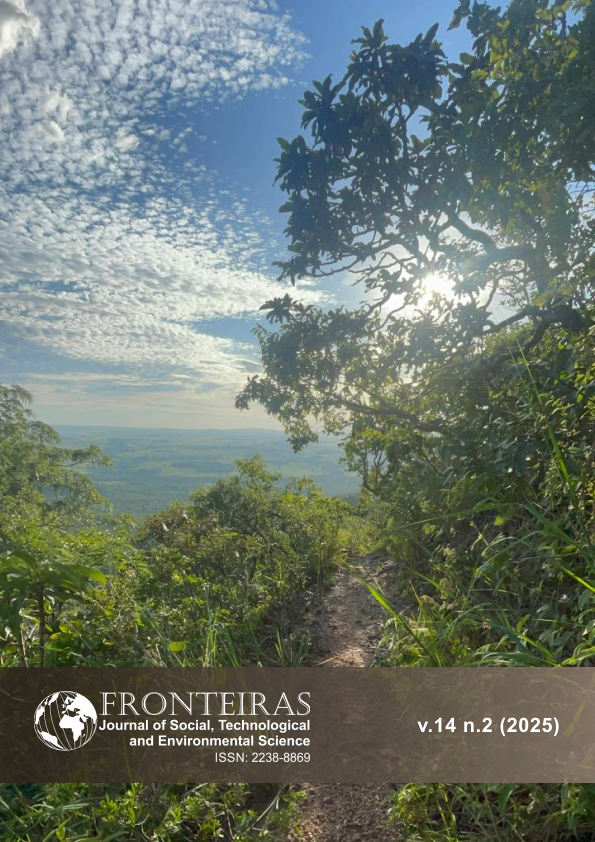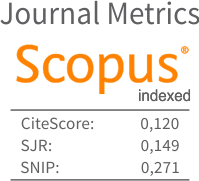Um Estudo Acerca do Design Biofílico como Técnica Sustentável em Ambiente Universitário
DOI:
https://doi.org/10.21664/2238-8869.2025v14i2.p110-129Palavras-chave:
espaço construído, sustentabilidade, bem-estarResumo
A biofilia se destaca como um recurso nos projetos construtivos ao promover a conexão entre pessoas e o ambiente e, consequentemente, conforto, bem-estar e felicidade. Este estudo teve como objetivo analisar a percepção de estudantes universitários em relação aos atributos do design biofílico e às técnicas sustentáveis empregadas no ambiente construído de uma universidade privada na região Sul do Brasil. Trata-se de um estudo de caso exploratório com abordagem mista. A amostra foi composta por 67 alunos de diversas áreas do conhecimento: saúde, exatas e humanas, que responderam a um questionário via Google Forms, utilizando a metodologia de bola de neve virtual. O questionário incluiu questões sobre as emoções positivas percebidas em relação aos elementos construtivos, percepção do ambiente construído e aspectos sociodemográficos. Verificou-se que os ambientes naturais geraram o maior número de emoções positivas, especialmente em locais com paisagens, materiais naturais e áreas ao ar livre, destacando-se as emoções de encantamento e relaxamento. Nos ambientes com elementos construtivos, os atributos mais valorizados foram a iluminação natural, a diversidade de funções, os elementos construtivos inovadores e a estrutura das salas de aula. No geral, os elementos de design biofílico mais relevantes para o desenvolvimento de emoções positivas foram a iluminação natural, as vistas para paisagens e os espaços ao ar livre. Observou-se também que as emoções positivas associadas ao ambiente universitário estavam vinculadas a características sustentáveis, como energia eólica, materiais recicláveis, materiais naturais e reaproveitamento da água. Constatou-se que o ambiente universitário com atributos do design biofílico voltados para a sustentabilidade pode induzir emoções positivas na comunidade acadêmica.
Referências
Abdelaal, Mohamed S. 2019. “Biophilic Campus: An Emerging Planning Approach for a Sustainable Innovation-Conducive University.” Journal of Cleaner Production. Elsevier Ltd. https://doi.org/10.1016/j.jclepro.2019.01.185.
Alves, Lidiane Aparecida, Adriano Reis de Paula e Silva, and Geisiane Rodrigues dos Santos. 2015. “Construir Cidades Sustentáveis Uma Oportunidade Para Uma Revolução Qualitativa Das Cidades.” Periódico Técnico e Científico Cidades Verdes 3 (4). https://doi.org/10.17271/23178604342015949.
Alves, Susana M. 2011. “Ambientes Restauradores.” In Temas Básicos Em Psicologia Ambiental, edited by Sylvia Cavalcante and Gleice A. Elali, 44–52. Petrópolis.
Barnes, Michael R, Marie L Donahue, Bonnie L Keeler, Cameron M Shorb, Tara Z Mohtadi, and Lacy J Shelby. 2018. “Characterizing Nature and Participant Experience in Studies of Nature Exposure for Positive Mental Health: An Integrative Review.” Frontiers in Psychology 9: 2617. https://doi.org/10.3389/fpsyg.2018.02617.
Beatley, Timothy, and Peter Newman. 2013. “Biophilic Cities Are Sustainable, Resilient Cities.” Sustainability 5 (8): 3328–45. https://doi.org/10.3390/su5083328.
Benedicto, Julia Brepohl, Ana Paula da Silva Siqueira, Catherine Menegaldi Silva, Edneia Aparecida de Souza Paccola, Regiane da Silva Macuch, and Rute Grossi Milani. 2019. “A percepção de discentes sobre a sustentabilidade em projetos arquitetônicos: caminhos para a promoção do bem-estar e da responsabilidade socioambiental.” Educação Ambiental Em Ação Ano XVIII. http://www.revistaea.org/artigo.php?idartigo=3693.
Berg, Agnes E. van den, Yannick Joye, and Sander L. Koole. 2016. “Why Viewing Nature Is More Fascinating and Restorative than Viewing Buildings: A Closer Look at Perceived Complexity.” Urban Forestry and Urban Greening 20: 397–401. https://doi.org/10.1016/j.ufug.2016.10.011.
Berman, Marc G., John Jonides, and Stephen Kaplan. 2008. “The Cognitive Benefits of Interacting with Nature.” Psychological Science 19 (12): 1207–12. https://doi.org/10.1111/j.1467-9280.2008.02225.x.
Berto, Rita. 2014. “The Role of Nature in Coping with Psycho-Physiological Stress: A Literature Review on Restorativeness.” Behavioral Sciences 4 (4): 394–409. https://doi.org/10.3390/bs4040394.
Bogerd, Nicole van den, S. Coosje Dijkstra, Karin Tanja-Dijkstra, Michiel R. de Boer, Jacob C. Seidell, Sander L. Koole, and Jolanda Maas. 2020. “Greening the Classroom: Three Field Experiments on the Effects of Indoor Nature on Students’ Attention, Well-Being, and Perceived Environmental Quality.” Building and Environment 171 (March): 106675. https://doi.org/10.1016/j.buildenv.2020.106675.
Bowler, Diana E, Lisette M Buyung-Ali, Teri M Knight, and Andrew S Pullin. 2010. “A Systematic Review of Evidence for the Added Benefits to Health of Exposure to Natural Environments.” BMC Public Health 10 (1): 456. https://doi.org/10.1186/1471-2458-10-456.
Calabrese, Elizabeth, and Stephen Kellert. 2015. The Practice of Biophilic Design.
Carrus, Giuseppe, Massimiliano Scopelliti, Angelo Panno, Raffaele Lafortezza, Giuseppe Colangelo, Sabine Pirchio, Francesco Ferrini, et al. 2017. “A Different Way to Stay in Touch with `Urban Nature’: The Perceived Restorative Qualities of Botanical Gardens.” FRONTIERS IN PSYCHOLOGY 8. https://doi.org/10.3389/fpsyg.2017.00914.
Castilla, Nuria, Carmen Llinares, Jose María Bravo, and Vicente Blanca. 2017. “Subjective Assessment of University Classroom Environment.” Building and Environment 122 (September): 72–81. https://doi.org/10.1016/j.buildenv.2017.06.004.
Chierrito-Arruda, Eduardo, Rosa, Ana Luisa Martins, Paccola, Edneia Aparecida de Souza, Macuch, Regiane da Silva, and Grossi-Milani, Rute. 2018. “Pro-environmental behavior and recycling: literature review and policy considerations.” Ambiente & Sociedade 21 (January). https://doi.org/10.1590/1809-4422asoc0209r3vu18l4ao.
Cooper, C., and B Browning. 2015. HUMAN SPACES: The Global Impact of Biophilic Design in the Workplace. Interface inc,.
Elali, G.A. 2003. “O Ambiente Da Escola: Uma Discussão Sobre a Relação Escola-Natureza Em Educação Infantil.” Estudos de Psicologia 8: 309–19.
Facey, A. D., V. Tallentire, R. M. Selzer, and L. Rotstein. 2015. “Understanding and Reducing Work-Related Psychological Distress in Interns: A Systematic Review.” Internal Medicine Journal 45 (10): 995–1004. https://doi.org/10.1111/imj.12785.
Flowers, Elliott P, Paul Freeman, and Valerie F Gladwell. 2017. “The Development of Three Questionnaires to Assess Beliefs about Green Exercise.” International Journal of Environmental Research and Public Health (Online) 14 (10). http://dx.doi.org/10.3390/ijerph14101172.
Golembiewski, Jan A. Salutogenic Architecture. The handbook of Salutogenesis, p. 259-274, 2022.
Hartig, Terry, and Peter H. Kahn. 2016. “Living in Cities, Naturally.” Science 352 (6288): 938–40. https://doi.org/10.1126/science.aaf3759.
Hartig, Terry, Richard Mitchell, Sjerp de Vries, and Howard Frumkin. 2014. “Nature and Health.” Annual Review of Public Health 35 (1): 207–28. https://doi.org/10.1146/annurev-publhealth-032013-182443.
Hartmann, Christopher D, Patricia A Marshall, and Aaron J Goldenberg. 2015. “Is There a Space for Place in Family History Assessment? Underserved Community Views on the Impact of Neighborhood Factors on Health and Prevention.” J Prim Prev 36 (2): 119–30. http://dx.doi.org/10.1007/s10935-015-0384-5.
Jones, David. 2013. “‘The Biophilic University’: A de-Familiarizing Organizational Metaphor for Ecological Sustainability?” Journal of Cleaner Production 48 (January): 148–65. https://doi.org/10.1016/j.jclepro.2013.02.019.
Kaplan, Stephen. 1995. “The Restorative Benefits of Nature: Toward an Integrative Framework.” Journal of Environmental Psychology 15 (3): 169–82. https://doi.org/10.1016/0272-4944(95)90001-2.
Kaplan, Stephen, and Marc G. Berman. 2010. “Directed Attention as a Common Resource for Executive Functioning and Self-Regulation.” Perspectives on Psychological Science 5 (1): 43–57. https://doi.org/10.1177/1745691609356784.
Kellert, Stephen. 2016. “Biophilic Urbanism: The Potential to Transform.” Smart and Sustainable Built Environment 5 (1). https://doi.org/10.1108/SASBE-10-2015-0035.
Klepeis et al. 2001. “The National Human Activity Pattern Survey (NHAPS): A Resource for Assessing Exposure to Environmental Pollutants.” Journal of Exposure Science & Environmental Epidemiology 11 (3): 231–52. https://doi.org/10.1038/sj.jea.7500165.
Lu, Hui, Weibo Zhang, Beidi Diao, Yan Liu, Hong Chen, Ruyin Long, and Shaohan Cai. 2021. “The Progress and Trend of Pro-Environmental Behavior Research: A Bibliometrics-Based Visualization Analysis.” Current Psychology, June. https://doi.org/10.1007/s12144-021-01809-1.
Malekinezhad, Fahimeh, Paul Courtney, Hasanuddin bin Lamit, and Mauro Vigani. 2020. “Investigating the Mental Health Impacts of University Campus Green Space Through Perceived Sensory Dimensions and the Mediation Effects of Perceived Restorativeness on Restoration Experience.” Frontiers in Public Health 8 (December). https://doi.org/10.3389/fpubh.2020.578241.
Okamoto, Jun. 2002. Percepção Ambiental e Comportamento: Visão Holística Da Percepção Ambiental Na Arquitetura e Comunicação. 3a. Mackenzie.
Olszewska-Guizzo, Agnieszka, Nicolas Escoffier, Jane Chan, and Tan Puay Yok. 2018. “Window View and the Brain: Effects of Floor Level and Green Cover on the Alpha and Beta Rhythms in a Passive Exposure EEG Experiment.” International Journal of Environmental Research and Public Health 15 (11): 2358. https://doi.org/10.3390/ijerph15112358.
Pasanen, Tytti, Katherine Johnson, Kate Lee, Kalevi Korpela, César San Juan, Mikel Subiza-Pérez, and Laura Vozmediano. 2017. “Can Nature Walks With Psychological Tasks Improve Mood, Self-Reported Restoration, and Sustained Attention? Results From Two Experimental Field Studies.” Frontiers in Psychology 9 (December): 2093. https://doi.org/10.3389/fpsyg.2017.02093.
Peralta, Arturo, Antonio Fernández-Caballero, and José Miguel Latorre. 2021. “Determining the Ambient Influences and Configuration of Optimised Environments for Emotional Wellbeing of Older Adults.” Ergonomics 64 (9): 1146–59. https://doi.org/10.1080/00140139.2021.1909756.
Reis, Juliana Ribeiro Gouveia, Sara Regina Ferreira, José Henrique Nunes Borges de Andrade, Ana Caroline Fernandes Marafon, and Mônica Andrade Morraye. 2012. “Vigilância Em Saúde Ambiental: Interferência Do Ambiente Na Saúde Humana Em Um Município de Minas Gerais.” Investigação 12 (2/3): 01–06.
Ribeiro, Mauricio Santana, Rafael Lima de Carvalho, Ary Henrique M. Oliveira, Glenda Michele Botelho, and Wandson Mendes Pessoa. 2019. “DESAFIOS GERADOS PELO CRESCIMENTO POPULACIONAL URBANO NO CONTEXTO DAS CIDADES INTELIGENTES.” Revista Observatório 5 (5): 667–96. https://doi.org/10.20873/uft.2447-4266.2019v5n5p667.
San Juan, César, Mikel Subiza-Pérez, and Laura Vozmediano. 2017. “Restoration and the City: The Role of Public Urban Squares.” Frontiers in Psychology 8 (December): 2093. https://doi.org/10.3389/fpsyg.2017.02093.
Scopelliti, Massimiliano, Giuseppe Carrus, and Marino Bonaiuto. 2019. “Is It Really Nature That Restores People? A Comparison with Historical Sites with High Restorative Potential.” Frontiers in Psychology. Scopelliti, Massimiliano: m.scopelliti@lumsa.it: Frontiers Media S.A. https://doi.org/10.3389/fpsyg.2018.02742.
Stokols, Daniel. 1992. “Establishing and Maintaining Healthy Environments: Toward a Social Ecology of Health Promotion.” American Psychologist 47 (1): 6–22. https://doi.org/10.1037/0003-066X.47.1.6.
Stoltz, Jonathan, and Christina Schaffer. 2018. “Salutogenic Affordances and Sustainability: Multiple Benefits With Edible Forest Gardens in Urban Green Spaces.” Frontiers in Psychology 9 (December). https://doi.org/10.3389/fpsyg.2018.02344.
Ulrich, Roger S. 1983. Behavior and the Natural Environment. https://doi.org/10.1007/978-1-4613-3539-9.
Ulrich, Roger S., Robert F. Simons, Barbara D. Losito, Evelyn Fiorito, Mark A. Miles, and Michael Zelson. 1991. “Stress Recovery During Exposure To Natural And Urban Environments.” Journal of Environmental Psychology 11: 201–30. https://doi.org/10.4049/jimmunol.180.5.3218.
Von Lindern, Eike; Lymeus, Freddie; Hartig, Terry. The restorative environment and salutogenesis: Complementary concepts revisited. The handbook of salutogenesis, p. 371-385, 2022.
Wang, Kuan, and Lu Zhang. 2021. “The Impact of Ecological Civilization Theory on University Students’ Pro-Environmental Behavior: An Application of Knowledge-Attitude-Practice Theoretical Model.” Frontiers in Psychology 12 (December). https://doi.org/10.3389/fpsyg.2021.681409.
Yin, Jie, and John D. Spengler. 2019. “Going Biophilic: Living and Working in Biophilic BuildingsLiving and Working in Biophilic Buildings.” In Urban Health, 369–74. Oxford University Press. https://doi.org/10.1093/oso/9780190915858.003.0040.
Zelenski, John M., and Jessica E. Desrochers. 2021. “Can Positive and Self-Transcendent Emotions Promote pro-Environmental Behavior?” Current Opinion in Psychology 42 (December): 31–35. https://doi.org/10.1016/J.COPSYC.2021.02.009.
Downloads
Publicado
Como Citar
Edição
Seção
Licença
Copyright (c) 2025 Patrícia Martins de Oliveira Pagano, Luciana Cristina Soto Herek, Flávia Aparecida Reitz Cardoso, Juliana de Castro Prado Friedrich, Alba Regina Azevedo Arana, Rute Grossi-Milani

Este trabalho está licenciado sob uma licença Creative Commons Attribution-NonCommercial 4.0 International License.
Esta revista oferece acesso livre imediato ao seu conteúdo, seguindo o princípio de que disponibilizar gratuitamente o conhecimento científico ao público proporciona maior democratização mundial do conhecimento.
A partir da publicação realizada na revista os autores possuem copyright e direitos de publicação de seus artigos sem restrições.
A Revista Fronteiras: Journal of Social, Technological and Environmental Science segue os preceitos legais da licença Creative Commons - Atribuição-NãoComercial 4.0 Internacional.


